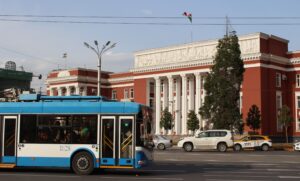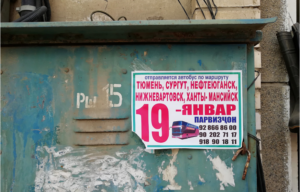Tajikistan has one of the highest emigration rates globally, with most Tajiks migrating to Russia for work. One million Tajiks are estimated to reside in Russia at any given time, sending crucial remittances back home. However, migration is not just about money. Novastan interviewed Dr Elena Borisova who, in her book, argues that social expectations related to what it means to be a ‘good’ person play a crucial role in motivating Tajiks to move to Russia.
Tajikistan’s economy is highly dependent on remittances. Approximately one million Tajiks reside in Russia, mostly for work. When in Russia, Tajiks face xenophobia, an increasingly restrictive migration regime and even the risk of being drafted into the Russian army to fight in Ukraine. What then motivates Tajiks to continue to move to Russia, despite the growing risks involved?
Read more on Novastan: Moscow attacks highlight Tajikistan’s radicalisation problem
To discuss the paradoxes of migration from Tajikistan to Russia, Novastan spoke to Dr Elena Borisova, a social anthropologist based at the University of Sussex. Originally from Russia, Elena has studied migration since 2012. While doing her first research inside Russia, she there met an ethnically Uzbek woman who invited Elena to join her on a trip to her native village in the north of Tajikistan. Later, in 2017-2019, Borisova spent fourteen months conducting ethnographic fieldwork as part of her PhD research there. Based on this research, she published her book ‘Paradoxes of Migration in Tajikistan: Locating the good life’, which is freely available at the website of UCL Press.
Common misconceptions about migration from Tajikistan
Elena Borisova highlights two common misconceptions about migration in Russia, which also apply to migration in general. First, migration is often seen as a ‘new’ phenomenon, without a history. As her colleagues Malika Bahovadinova and Isaac Scarborough showed, in the late Soviet period, there were programs to resettle Central Asians to Russia. These were often unsuccessful, as Central Asians did not want to move. Russian ethnographers and sociologists explained this failure as the result of inherent traditionalism in Central Asia. However, when the Central Asian republics experienced deep economic crises after the fall of the Soviet Union, many Central Asians did migrate to Russia, which caught many Russian researchers by surprise.
Second, migration is often explained with the help of economic theories, in which migrants are exclusively seen as rational actors trying to maximise their economic benefits. This is coupled with ‘push-pull’ logic: Central Asia has a ‘labour excess’, which leads to a ‘flow’ of migrants that is ‘absorbed’ by Russia’s economy. This obscures the motivations and experiences of the individual migrants, and the obstacles they face. Why do Tajiks feel they need to migrate? Motivations vary.
Migration as a way to live the ‘good’ life
Elena Borisova’s work shows that migration is intimately linked with people’s pursuit of living a ‘good’ life. This is not just about getting ahead economically, but also about being recognised as a good person by your community. To achieve this status, one must engage in major life projects, such as getting married, building a house, getting children and caring for the elderly, in a good and timely manner. After the Soviet Union collapsed it became practically impossible to achieve these things while working in Tajikistan. So, migration emerged as an alternative way to fulfil social expectations.
The village where Elena Borisova lived and conducted her ethnographic fieldwork, in Sughd province in the north of Tajikistan, was transformed by the Soviet modernisation project in the 1950s. A factory was built, which provided work and infrastructure. Schools, kindergartens, libraries and even a House of Culture were built, which gradually transformed people’s lifestyles. Goods produced at the local factory were shipped all the way to Moscow, and the local youth travelled throughout the USSR for education and military service. Graduates from around the Soviet Union also moved to Tajikistan to work, and people with different ethnicities mingled at work in the factory and during social activities. Russian became the lingua franca as it was seen as an integral part of this modernity.
After the collapse of the Soviet Union, the ‘modernity’ that had emerged came under pressure. The movements of goods and people throughout the Soviet space came to a standstill, and infrastructure gradually degraded. These changes were experienced as isolating the village. Interethnic social relations declined when the factory and social facilities shut down. Migration to Russia slowly started in the 1990s but really took off in the early 2000s, after the border with Uzbekistan had closed. Going to Russia was an attempt of retaining modernity, which was already linked to mobility since the very emergence of the new industrialised place on the map. It was not just about closing a financial gap, but also about perceiving the ideal of being a modern, cultured person.
Retaining modernity
A tragic paradox arises in that when Tajiks come to Russia, these modes of self-fashioning are not relevant in Russian society. The Russian migration regime sees Central Asians as unskilled, disposable labour migrants. The Tajiks are there to create modernity for the Russian middle classes but are never recognised by the Russians as being modern themselves.
While the conceptions of the ‘good’ life in different parts of Tajikistan might vary, they are always bound up with social expectations that can be contradictory. In her book, Borisova highlights the example of a man who is a single child and does not have a son himself. This requires him to simultaneously care for his immediate family and his elderly parents, for which he needs to be physically present in his village. However, he is also expected to provide for them financially, to build a house and to organise important festivities. This forces him to move to Russia to work and make money. These contradictory social expectations make him move back and forth between Russia and Tajikistan constantly, which puts a lot of pressure on him.
Weddings are particularly important social events that mark the creation of a new family, and a person’s gender and place in the extended family. To be perceived as a good person you need to have your wedding in a timely manner, before you are considered too old. Weddings then create social obligations between people and are important in establishing social networks. If you invite someone to your wedding, they ‘owe’ you and you can turn to them for future help.
The scope of festivities has differed over time, and some research suggests that they were the largest in late Soviet times. Festivities shrank during the post-Soviet economic downturn and the civil war in the 1990s but have increased in size again due to migration. Working in Russia has given people access to more financial means, and this has exacerbated competition when it comes to feasts. People feel pressured to organise larger and larger family events and are often forced to go to Russia to make enough money to pay for them.
Another paradox relates to citizenship. Russia has tightened its migration regime since 2012, and in 2016 introduced a blacklist of Tajiks who are not allowed to enter Russia. To avoid being blacklisted, many Tajiks have tried to obtain Russian citizenship. However, this should not be seen as them ‘belonging’ to Russia, but rather as an attempt to facilitate meeting social obligations and expectations at home. This, rather than ‘legality’, is their main concern. People are concerned with entry bans and illegal status only as far as it troubles the temporalities of their social being.
The impact of Russia’s invasion of Ukraine
Dr Borisova’s current research together with Dr Malika Bahovadinova examines how Russia weaponizes the institute of citizenship to attract manpower for its war in Ukraine. The regime grants citizenship as a reward for doing military service and threatens with police violence or revoking citizenship when naturalised citizens fail to meet military expectations. The Tajiks are using their decades worth of knowledge about Russia’s bureaucracy and changing migration laws to navigate these new existential risks.
Read more on Novastan: How Russia is recruiting Central Asian soldiers for its war in Ukraine
In Russian media, this has resulted in a new popular construct – that of a ‘migrant with a Russian passport’. This concept shows how the distinction between a migrant and a citizen is obfuscated. Developments like these change the perception that Tajiks have of Russia, and of migrating there. That is why many Tajiks are looking to move elsewhere. Yet, this is often easier said than done. Tajiks have established themselves in Russia for decades. They often own property there, and their children often only speak Russian.
Central Asian governments are also exploring new destinations for their citizens to work. For example, Uzbekistan signed agreements with different countries, including with Germany, which has recruited Uzbek care workers. Uzbekistan also seeks to strengthen cooperation with Saudi Arabia, South Korea, Turkey, and the UK as potential recipients of migrant workers.
Time will tell whether the diversification of Central Asian migrant workers’ destinations will continue.
The interview has been edited for length and clarity.
For more news and analysis from Central Asia, follow us on Twitter, Facebook, Telegram, Linkedin or Instagram.
 The paradoxes of migration from Tajikistan to Russia: an interview with Dr Elena Borisova
The paradoxes of migration from Tajikistan to Russia: an interview with Dr Elena Borisova 



